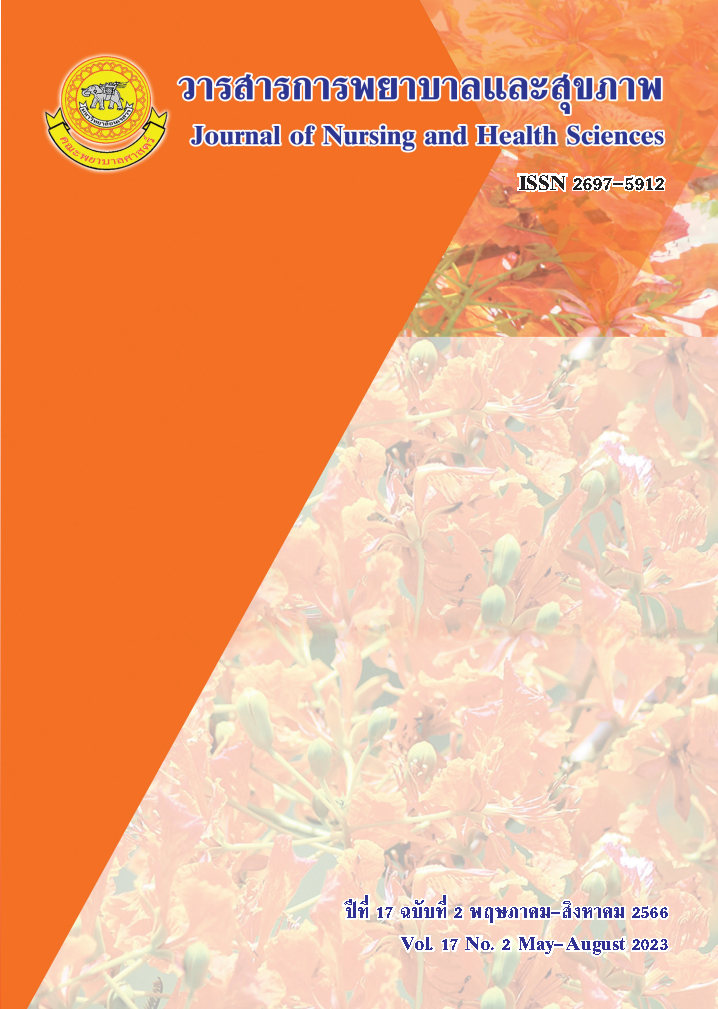ผลของการพัฒนาผู้เรียนตามลักษณะการเรียนรู้VARK ต่อความคิดสร้างสรรค์ และผลสัมฤทธิ์ทางการเรียนของนักศึกษาพยาบาล
Main Article Content
บทคัดย่อ
การวิจัยกึ่งทดลองนี้เพื่อศึกษา วิธีการจัดการเรียนการสอนโดยใช้ลักษณะการเรียนรู้ของผู้เรียนเป็นตัวกำหนดความสามารถในการพัฒนาความคิดสร้างสรรค์และผลสัมฤทธิ์ทางการเรียนของนักศึกษาพยาบาลศาสตร์ กลุ่มตัวอย่าง คือ นักศึกษาพยาบาลชั้นปีที่ 1 จำนวน 130 คน เลือกกลุ่มตัวอย่างแบบ Purposive sampling เครื่องมือวิจัยเป็นแบบวัดความคิดสร้างสรรค์ แบบประเมินลักษณะการเรียนรู้ (VARK) และแบบวัดผลสัมฤทธิ์ทางการเรียนวิชากายวิภาคศาสตร์และสรีรวิทยา เครื่องมือที่ใช้ผ่านการตรวจสอบความตรงตามเนื้อหา (Content validity) ค่าดัชนีความตรงได้เท่ากับ .76และความเที่ยง (Reliability) ของแบบวัดความคิดสร้างสรรค์ โดยวิธีของคูเดอร์-ริชาร์ดสัน KR20 (r=.74) วิเคราะห์ข้อมูลด้วยสถิติพรรณนา สถิติ t-test independent ผลการวิจัยครั้งนี้พบว่า กลุ่มตัวอย่างมีลักษณะการเรียนรู้แบบ VARK ที่แตกต่างกัน คือ ลักษณะการเรียนรู้แบบการมองเห็น (Visual=V) ร้อยละ 45.42 ลักษณะการเรียนรู้แบบการพูดฟัง (Aural = A) ร้อยละ35.6 และ ลักษณะการเรียนรู้แบบการอ่านเขียน (Read/write=R) และแบบการลงมือปฏิบัติ (Kinesthetic = K) ร้อยละ 18.98 เมื่อเปรียบเทียบคะแนนความคิดสร้างสรรค์ของกลุ่มตัวอย่างก่อนการเรียนรู้ด้วยการสร้างชุดเกมส์การเชื่อมโยงความรู้ และ Mind mapping พบว่า มีความแตกต่างกันอย่างมีนัยสำคัญที่สถิติ (t=2.385, p = .019) แต่หลังการทดลองไม่มีความแตกต่างกัน (t=.716, p=.475) และเมื่อเปรียบเทียบผลสัมฤทธิ์ของนักศึกษาก่อนและหลังการเรียนรู้ด้วยการสร้างชุดเกมส์การเชื่อมโยงความรู้ และ Mind mapping ไม่มีความแตกต่างกัน (t=-1.292, p=.199 ) ซึ่งสรุปได้ว่าการจัดการเรียนการสอนตามลักษณะการเรียนรู้แบบ VARK พบความแตกต่างของลักษณะความคิดสร้างสรรค์ระหว่างกลุ่มตัวอย่างทั้งสองกลุ่มแต่ ไม่ส่งผลต่อผลสัมฤทธิ์ทางการเรียนของกลุ่มตัวอย่าง
Article Details

อนุญาตภายใต้เงื่อนไข Creative Commons Attribution-NonCommercial-NoDerivatives 4.0 International License.
เอกสารอ้างอิง
Amabile, T.M. (1996). Creativity and innovation in
organization. Harvard Business School Background
Note 396-239, January 1996.
Amaniyan, S., Pouyesh, V., Bashiri, Y., Snelgrove, S.,
&Vaismoradi, M. (2020). Comparison of the
conceptual map and traditional lecture methods on
students’ learning based on the VARK learning style
model: A randomized controlled trial. SAGE Open
Nursing. 6(1–9). Retrieved 1 August 2022 from
https:// creativecommons.org/licenses/by/4.0/
Brahmawong , C. (2019). Guidelines for educational
development for Thailand 4.0 to Thailand 5.0 by the
education reform council of the people’s sector, 2019.
Journal of Educational Technology and Communication, 16(1), 1-15. [In Thai].
Butchui , P. (2019). The transition from innovation 4.0
to the use of educational innovation 5.0 must adhere
to the principle of participation. Nonthaburi: Office
of Educational Technology Sukhothai Thammathirat
Open University. [In Thai].
Charoenwongsak, K. (2010). Creative thinking (8th ed.).
Bangkok: Success Media Co., Ltd. [In Thai].
Chitrakorn, A. (2017). Development of collaborative
teaching and learning management that uses
techniques for solving problems in the future. To
promote creativity in graphic design for teaching
materials of undergraduate students Faculty of
Education Silpakorn University. Silpakorn University
Journal, 37(1), 23-41. [In Thai].
Chularut, P. (2018). Learning management for learners
in Thailand 4.0 Era. Veridian E-Journal, 11(2),
-2377. [In Thai].
Devakul, N. (2016). Creative thinking. E book . Bangkok:
Office of the Civil Service Commission. Retrieved
August 2022 from https://www.ocsc.go.th/ . [In
Thai].
Fleming, N. & Bonwell, C. (2019). How do I learn best?
A student’s guide to improved learning (2nd ed.). New
Zealand: VARK Learn Ltd.
Hanmongkolpipat, P. (2018). Minutes of the 9th National
and international Hat Yai academic conference on
teaching and learning in game format. Songkhla :
Hat Yai University. [In Thai].
Hong-rui, Z., Hui, Z., Hua, Z., Hong-yu, Z., Feng-jing
W., Hong-hua, G.,&Cai-hong, Z. (2018). The
preferred learning styles utilizing VARK among
nursing students with bachelor degrees and associate
degrees in China. Acta Paul Enfer, 31(2), 162-169.
Janepanish V., & Disorntatiwat , P. (2015). Learning
styles of nursing students Ramathibodi Nursing
School Faculty of Medicine Ramathibodi Hospital
Mahidol University. Journal of Nursing Ministry of
Public Health, 25(1), 70-82. [In Thai].
Nakasan, N., & Nakasan, C. (2010). Game: Innovation
for creative education. Rompruek Journal Krirk
University, 34(3), 160-179. [In Thai].
Office of Higher Education Policy and Planning. (2018).
Long-term higher education strategy for the next 20
years (2018-2037). Piyawang Graphics Co., Ltd. [In
Thai].
Patitat, P. (2016). Systematic and creative thinking.
Bangkok: O.S. Printing House Co., Ltd. [In Thai].
Phonan, K., & Phonan, T. (2007). MIND MAP with
education and knowledge management. Bangkok:
PS Printing and Design Co., Ltd. [In Thai].
Pissachart, N., Techasatian, K., Juthamanee, S., &
Leelakraiwan, C. (2018). Learning styles of nursing
students Faculty of Nursing Shinawatra University,
Police Nursing Journal,10(1), 173-179. [In Thai].
Ruggiero, V. R. (1999). Becoming a critical thinker (3rd
ed.). New York: Houghton Mifflin.
Satraphart, D. (2015). Creativity. Journal of Health and
Health Management, 1(1), 10-22. [In Thai]
Sinlarat, P. (2019). Transforming innovation 4.0 to
innovation education 5.0 must adhere to the
principle of participation. Retrieved 1August 2022
from https://mgronline.com/qol/detail/9620000033966.
[In Thai].
Soontornnon, P., & Natthaphatwirata , R . (2022).
Media-based reality learning and VARK learning
model using the brain as a base. Education Journal
Naresuan University, 24(3), 347-359. [In Thai].
Suklim, R., & Tiantong, M. (2017). Analysis of learning
styles of undergraduate students of King Mongkut’s
University of Technology North Bangkok according
to VARK learning style using C4.5 algorithm tree
diagram analysis. NCCIT 2012 The eight national
conference on Computing and Information
Technology, 416-427. [In Thai].
Tewakul, N. (2017). Creative Thinking. Retrieved 1
August 2022 from http:/pirun.ku.ac.th/agrpct2/lesson1/
creative_thinking.html. [In Thai].
The Announcement of the Ministry of Education on
Qualification Standards of. Bachelor Degree Level
in Nursing Science, B.E. 2560. (2017). Retrieved
July 2022 from http://www.mua.go.th/users/tqf.
[In Thai].
Wattanakul, B., Ngamkham, S., & Ngamwongwan, K.
(2018). Differences in learning styles of nursing
students. Journal of Health Science Research, 10
(1), 54-56. [In Thai].


